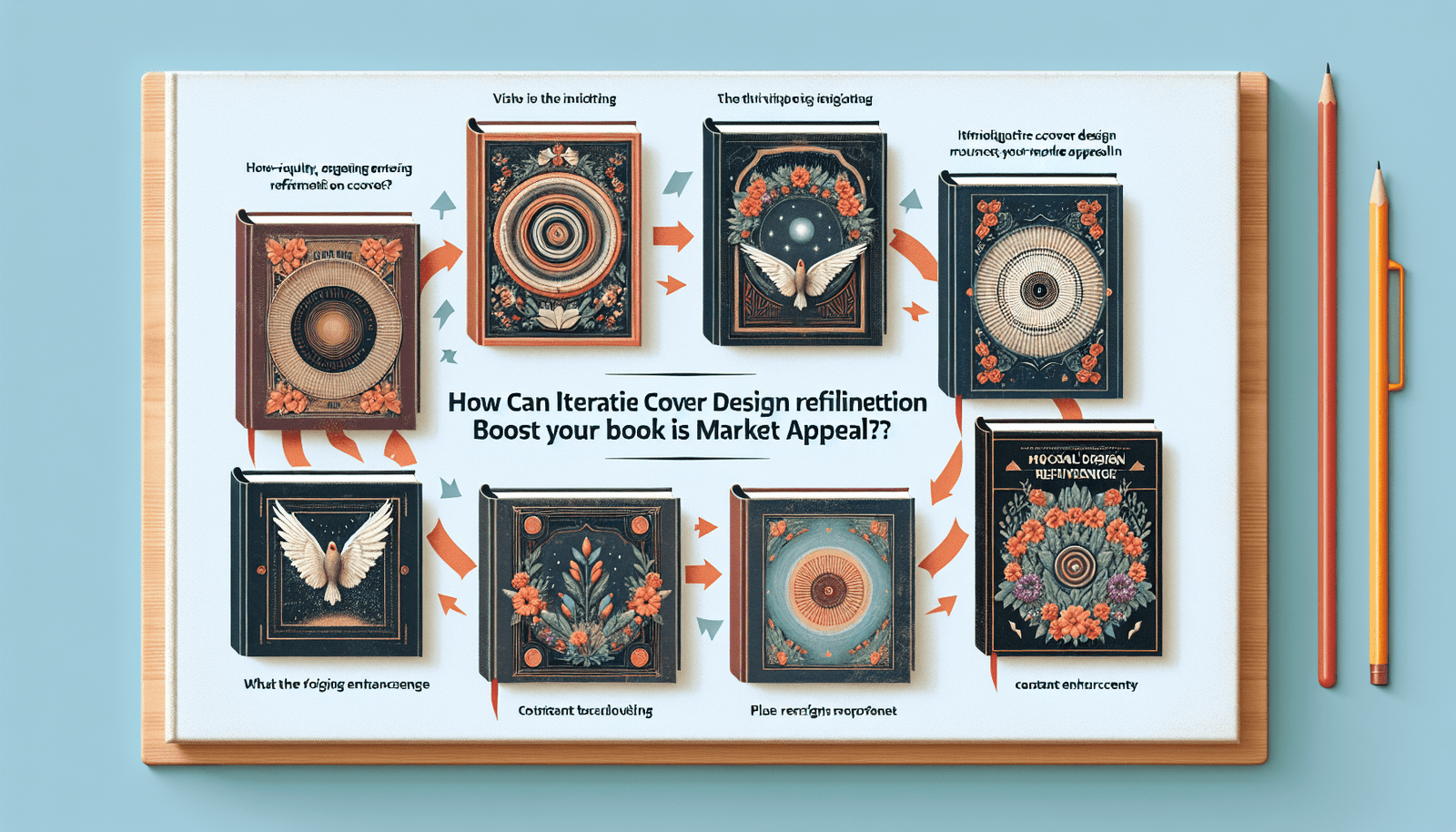You’re about to discover the secret sauce that can make your book fly off the shelves! In “How Can Iterative Cover Design Refinement Boost Your Book’s Market Appeal?” you’ll dive into the fascinating process of repeatedly tweaking and improving your book’s cover design to maximize its visual allure and, ultimately, its sales potential. This article reveals why the first impression matters so much in the literary world and how you can leverage continuous refinement to ensure your book cover captivates readers at first glance. Get ready to transform your book’s market presence and make it irresistibly appealing!
Have you ever wondered why some books catch your eye while others don’t even get a second glance? The secret often lies in the cover design. Welcome to the world of iterative cover design refinement, a strategic process that can significantly boost your book’s market appeal.
Why Does Cover Design Matter?
Your book cover serves as the first impression potential readers will have of your work. It’s your golden opportunity to capture attention in a fraction of a second. A poorly designed cover can turn away even the most interested buyer, while a stunning cover can lure in even the most casual browser.
Setting Expectations
A well-designed cover gives readers a hint about what lies within. Whether your book is a thrilling mystery, a heartwarming romance, or a thought-provoking non-fiction, your cover sets the expectation. Misleading covers can disappoint readers, and disappointed readers often lead to poor reviews.
The Power of First Impressions
People do judge books by their covers, and a compelling cover can make the difference between someone picking up your book or moving on to the next. It’s about capturing attention quickly and conveying your story’s essence instantly.
What is Iterative Cover Design?
Iteration is the process of refining a product through repetitive cycles of design, testing, feedback, and improvement. In terms of cover design, iterative refinement means continuously improving your cover design based on feedback and performance until you hit upon the winning formula.
The Cycle of Improvement
Think of an iterative process as a loop: you create a design, test it with your audience, gather feedback, and then refine the design based on that feedback. This cycle continues until you achieve a cover that strongly resonates with your target audience.
Why Doesn’t One Design Fit All?
Tastes and preferences vary greatly from one reader to another. What works for one demographic might not appeal to another. An iterative approach allows you to tweak your design to better fit the tastes of your specific target audience.
The Process of Iterative Cover Design Refinement
Understanding the process is the first step towards employing it successfully. Let’s break it down into more manageable steps.
Step 1: Initial Conceptualization
This is where you brainstorm ideas and create rough sketches or prototype designs. Consider your book’s genre, target audience, and key themes. This initial design doesn’t have to be perfect; it serves as a starting point.
Step 2: Audience Testing
Once you have a few initial designs, test them with a sample of your target audience. This can be done through surveys, focus groups, or even online polls. Ask detailed questions to understand what they like or dislike about each design.
Step 3: Gathering Feedback
Feedback is your best friend in the iterative process. Pay close attention to what your audience says. Are some elements universally loved or hated? Is your cover attracting the right kind of attention?
Step 4: Refinement
Use the feedback you’ve gathered to make improvements. This could mean anything from altering the color scheme to tweaking the title’s font. Make the necessary changes and prepare for another round of testing.
Step 5: Repeat the Cycle
Go back to audience testing with the refined designs. This cycle should continue until you consistently receive positive feedback on a particular design. Remember, perfection is a myth, but strong, positive resonance is your goal.
Real-World Examples of Iterative Cover Design
To give you a clearer picture, let’s look at some real-world examples where iterative cover design played a crucial role.
Example 1: “Gone Girl” by Gillian Flynn
The initial cover designed for “Gone Girl” was simple and somewhat misleading. After receiving lukewarm feedback, the publishers went back to the drawing board. They eventually came up with a more compelling design that significantly increased the book’s appeal and sales.
Example 2: “Atomic Habits” by James Clear
James Clear’s “Atomic Habits” went through several design iterations. The final cover, which features a minimalistic yet striking design, underwent countless tweaks based on reader feedback. This iterative process contributed to its status as a bestseller.
Tools for Effective Iterative Design
Several tools can assist you in each phase of the iterative design process, from initial conceptualization to gathering feedback and making refinements.
Design Tools
- Adobe Creative Suite: Industry-standard tools like Photoshop and Illustrator.
- Canva: A more user-friendly option for non-designers.
- Procreate: Ideal for illustrators who prefer sketching on tablets.
Feedback and Testing Tools
- SurveyMonkey: For creating detailed surveys to gather reader feedback.
- Google Forms: A free alternative for conducting simple polls.
- UsabilityHub: Allows you to test your designs with a wide audience and get rapid feedback.
Refinement Tools
- Trello: For project management and tracking iterative tasks.
- Slack: For team communication and collaboration.
Common Pitfalls and How to Avoid Them
Knowing the common mistakes can save you a lot of time and frustration. Here are some pitfalls to watch out for.
Over-Reliance on Personal Taste
Your preference may not align with that of your target audience. Always prioritize audience feedback over personal inclinations.
Ignoring Negative Feedback
Negative feedback is just as valuable, if not more so, than positive feedback. It helps you identify areas that need improvement.
Skipping Steps
The iterative process is only effective if you adhere to all its steps – from conceptualization to refinement. Skipping steps can lead to a flawed final product.
Benefits of Iterative Cover Design Refinement
Employing an iterative approach to your cover design can offer numerous benefits.
Increased Market Appeal
A well-refined design will resonate more with your target audience, increasing the likelihood of your book being picked up and read.
Improved Sales
Books with compelling cover designs often enjoy better sales. The iterative process ensures your cover is as marketable as possible.
Strengthened Brand Identity
Consistency in design, achieved through iterative refinement, can help strengthen your brand as an author. This is particularly useful if you plan on writing multiple books.
How to Know When You’re Finished
One of the most challenging aspects of iterative refinement is knowing when to stop. Here are a few indicators.
Consistently Positive Feedback
If your design consistently garners positive feedback across multiple rounds of testing, it’s a good sign you’re on the right track.
Meeting Your Objectives
Have you achieved the initial goals set out for this design? Whether it’s capturing a specific market segment or conveying a particular theme, meeting these goals can be a good stopping point.
Sales and Market Response
If you’re already seeing an uptick in sales or receiving positive responses from early reviewers, it might be time to conclude the iterative process.
Final Thoughts: Iterative Design as an Ongoing Strategy
Even after your book is published, maintaining an iterative mindset can be beneficial. Market trends change, and what works today might not work tomorrow. Stay open to feedback and be willing to make adjustments as needed.
Your Journey
Remember that the journey of iterative cover design refinement is unique to each author. Stay patient, keep an open mind, and don’t be afraid to experiment. Your efforts will pay off, making your book more appealing to the market and ultimately boosting its success.
Continuous Learning
Lastly, treat every project as a learning opportunity. The insights gained from one book cover can inform the next, helping you to continually refine and perfect your approach.
By embracing the process of iterative cover design refinement, you are investing in your book’s success. Happy designing!



